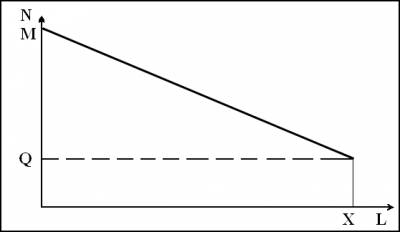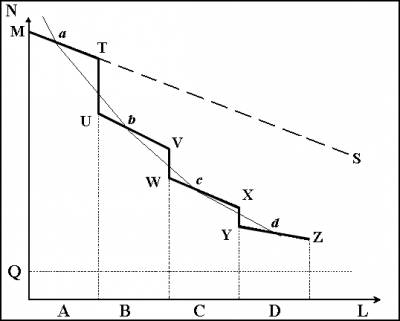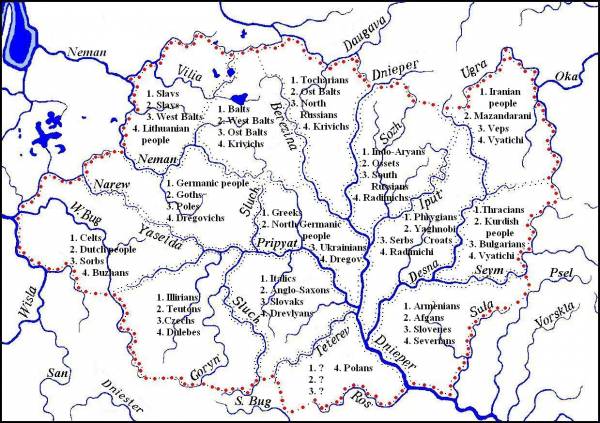
Main Postulates
The study of prehistoric ethnogenic processes was performed in accordance with the following postulates:
The first postulate – Language continuum.
Guided by the conclusions of certain scholars of the past (PAUL H. 1960, 58.) we can assume that when some people settle on a vast and plain territory with no special geographical obstacles during the process of its cultural formation, at some point the increase of its vocabulary connected with these advances will eventuate in the development of isolated dialects from the original unitary language of this people. And these dialects will produce such language continuum that will result in the differences between isolated dialects that increase monotonously and proportional to the distance separating certain ethnical groups as speakers of these dialects.
Almost ideal conditions for such language development, according to the described scenario, existed in plain Australia which is not crossed by big rivers. A Russian scholar V.A. Shnirelman describes the language situation in Australia:
Almost ideal conditions for such language development, according to the described scenario, existed in plain Australia which is not crossed by big rivers. A Russian scholar V.A. Shnirelman describes the language situation in Australia:
“Language continuum was characteristic for Australian aborigines, i.e. tongues or dialects of adjacent groups demonstrated large similarity and their speakers understood each other well, whereas mutual intelligibility gradually disappeared with the distance between the groups” (SHNIRELMAN V.A.,1982, 88).
If we graphically reflect the described language situation in our hypothetical territory of Australian type, it has the appearance of the line MS on figure below

The second postulate – Chronological stratification of the lexical stock.
If primary people had their language with the total number of lexical items – Q from the outset of its settlement at certain territory, the new dialects continuum could develop in two ways:
1. by the production and interchange of new words among the dialects with the increase of Q in the language,
2. by decrease of initial total Q in each dialect. But the both processes develop with different speed. The process of the producing and interchange of new words develops quicker than the loss of some words in initial total vocabulary. As the result, the entire vocabulary stock of each dialect can be divided into two layers – words derived from parent language which we shall later name as the words of the first level and new words which we shall name as the words of the second level.
It is important to clarify this above-postulated correlation of the mutual words volume and the distance between the dialects, as, in fact, it is influenced only by the words of the second level, because the words of the first level remain in approximately equal quantity at each time point in all the dialects.
1. by the production and interchange of new words among the dialects with the increase of Q in the language,
2. by decrease of initial total Q in each dialect. But the both processes develop with different speed. The process of the producing and interchange of new words develops quicker than the loss of some words in initial total vocabulary. As the result, the entire vocabulary stock of each dialect can be divided into two layers – words derived from parent language which we shall later name as the words of the first level and new words which we shall name as the words of the second level.
It is important to clarify this above-postulated correlation of the mutual words volume and the distance between the dialects, as, in fact, it is influenced only by the words of the second level, because the words of the first level remain in approximately equal quantity at each time point in all the dialects.
The third postulate – Ethno-generating areas..
The newest interdisciplinary researches on the osculation of humanities and natural sciences put under the theoretical base for the application of the study by means of the graphic- analytical method. The impulse to the new approach to such researches was given by the work of B. B. Mandelbrot “The Fractal Geometry of Nature”(MANDELBROT B. B, 1982.) where the author has introduced in scientific employment the category of the fractal. This term characterizes a geometrical figure composed by parts which are similar to this figure. Using the category of the fractal in synergetic natural systems, Czech scientist Radan Květ substantiates the theory of four joined nets in the nature:
- the net of geological fault lines;
- the hydrological net;
- the net of prehistoric paths;
- the information net.
The essence of this theory is such. The faults of Earth's crust and specially the fault zones with inclination from highest points to the sea level conditioned the configuration of the hydrological net of water streams. Mainly on the first benches along rivers, footpaths were put by man absolutely unintentionally, and the net of prehistoric paths was simultaneously the primary information net. This net promoted the widening of technological experience, world-view ideas, artistic tastes etc (KVĚT R., 1998, 43, KVĚT RADAN. 2000,294.) It is clear that new words corresponding to new conceptions were widened together with the widening of experiences and ideas. However one has to bear in mind that the hydrological net is very discrete and water streams can as assist to the human intercourse as to prevent this. Little rivers and footpaths along them form local areas of human intercourse which can be limited by large river as hard to overcome obstacles for the widening of new information. Thus human communities joined by common language (dialect) and common cultural tradition were arisen in certain such areas. The geographical peculiarities of these areas resulted that the making of new ethnic communities can eventuate on them more than once. Therefore they cam be called the ethno-generating areas. However the primary ethnic communities arisen on the ethno-generating areas did not lose the intercourse with such adjacent ones, though the information exchange ran less intensive as inside of the area. While uprising of ethnic consciousness, conditioned by feeling of the difference in languages and cultures of primary ethnic communities, the process of their separation already goes knowingly, when people on the opposed bank of the river are perceived as other or strange ones. The river itself becomes not only a natural frontier but also as a psychological border between ethnic communities. Having in mind fractal construction of Earth’s surface, one can purpose that totality of next ethnic communities may to differ from another such totality in more large degree as ethnic communities inside totality. It is clear that natural frontiers can be not only large rives but also mountain chains, big forests, swamps etc.
Making out primeval ethnic communities is impossible without the self-perceiving of such community by its members. However this self-perceiving is impossible without common language. The role of geographic environment in making the primeval ethnic communities was emphasized already in 1940 by Jaromír Korčak:
- the net of geological fault lines;
- the hydrological net;
- the net of prehistoric paths;
- the information net.
The essence of this theory is such. The faults of Earth's crust and specially the fault zones with inclination from highest points to the sea level conditioned the configuration of the hydrological net of water streams. Mainly on the first benches along rivers, footpaths were put by man absolutely unintentionally, and the net of prehistoric paths was simultaneously the primary information net. This net promoted the widening of technological experience, world-view ideas, artistic tastes etc (KVĚT R., 1998, 43, KVĚT RADAN. 2000,294.) It is clear that new words corresponding to new conceptions were widened together with the widening of experiences and ideas. However one has to bear in mind that the hydrological net is very discrete and water streams can as assist to the human intercourse as to prevent this. Little rivers and footpaths along them form local areas of human intercourse which can be limited by large river as hard to overcome obstacles for the widening of new information. Thus human communities joined by common language (dialect) and common cultural tradition were arisen in certain such areas. The geographical peculiarities of these areas resulted that the making of new ethnic communities can eventuate on them more than once. Therefore they cam be called the ethno-generating areas. However the primary ethnic communities arisen on the ethno-generating areas did not lose the intercourse with such adjacent ones, though the information exchange ran less intensive as inside of the area. While uprising of ethnic consciousness, conditioned by feeling of the difference in languages and cultures of primary ethnic communities, the process of their separation already goes knowingly, when people on the opposed bank of the river are perceived as other or strange ones. The river itself becomes not only a natural frontier but also as a psychological border between ethnic communities. Having in mind fractal construction of Earth’s surface, one can purpose that totality of next ethnic communities may to differ from another such totality in more large degree as ethnic communities inside totality. It is clear that natural frontiers can be not only large rives but also mountain chains, big forests, swamps etc.
Making out primeval ethnic communities is impossible without the self-perceiving of such community by its members. However this self-perceiving is impossible without common language. The role of geographic environment in making the primeval ethnic communities was emphasized already in 1940 by Jaromír Korčak:
“Tribal belonging is a basic and objective characteristic of people as it contains full geographic and genetic interconnection. Social organization which leads to common language and culture arises only in this interconnection… It is obvious that people originality is impossible to hold without peculiar soul atmosphere communicated by own language” .(JAROMÍR KORČAK, 1940, 6.)
In the case of the existing of natural frontiers, the number of the mutual items in the particular dialects of the parent language decreases with the increase of the distance between the settlements of their speakers within the ethno-generating areas but it decreases abruptly at the language boundaries. It is possible that more or less constant part of the mutual words of the second level disappears at the each passing of the boundary. In that case the distribution of mutual words depending on the distance has the appearance of the broken line MTUVWXYZ on the figure below

Distribution of the number of mutual lexical items between dialects in areas, separated by ethnical boundaries.
N – the number of mutual lexical items in dialects; L – the distance between the habitats (areas); Q – the number of first level lexical items, being the same for all dialects; M – the total number of words in an isolated dialect; AB, BC, CD, DE, – areas of isolated dialects.
This distribution has too complex mathematical expression. But if we agree to consider newly developed isolated dialects within areas AB, BC, CD, DE as separate language units, we can consider the distance between them to be equal to the distance between their area centres. Thus, connecting the centres of segments MT, UV, WX, YZ, we obtain the distribution of mutual lexical items (words, for simplicity) in dialects as the line abcd. And if we move the origin of the co-ordinate to the point Q, we’ll see that the shape of this line in its central part will be close to hyperbola; therefore it can be described with the function of inverse proportionality y=k/x. In this case, the correlation of the number of words of the second level in the dialects and the distance between the centres of habitats can be approximately described with the formula M-Q = K/L, where K is the coefficient of proportionality.
Certain inaccessibility of habitats of isolated dialect speakers will eventuate in such difference between these dialects that the parent unitary language will split into new distinct languages which we shall call further the languages of the second level. These languages can derived again and produce new languages of the third level, if the second level language speakers migrate to a new large territory. The combined complex of words of the first and second levels will remain in the languages of the third level. This process can continue further on producing the family tree of monophyletic languages.
As the result of this process the great deal of the word complex of low levels was conserved in the languages of the higher levels, but only words of the highest level will be subordinate to the law of inverse proportionality, i. e. when the number of mutual words of this level are depended on the distance between the ethno-generating areas of languages. Thus when we analyse languages of the higher levels, we have to remove all the words of lower levels from the study, as a rule, such words are common for all analysed languages, and it considerably facilitates their exclusion.
Certain inaccessibility of habitats of isolated dialect speakers will eventuate in such difference between these dialects that the parent unitary language will split into new distinct languages which we shall call further the languages of the second level. These languages can derived again and produce new languages of the third level, if the second level language speakers migrate to a new large territory. The combined complex of words of the first and second levels will remain in the languages of the third level. This process can continue further on producing the family tree of monophyletic languages.
As the result of this process the great deal of the word complex of low levels was conserved in the languages of the higher levels, but only words of the highest level will be subordinate to the law of inverse proportionality, i. e. when the number of mutual words of this level are depended on the distance between the ethno-generating areas of languages. Thus when we analyse languages of the higher levels, we have to remove all the words of lower levels from the study, as a rule, such words are common for all analysed languages, and it considerably facilitates their exclusion.

Map of Ethno-generating areas in Eastern Europe illustrating alternation of substratum influences.
At different time parent languages were separated in dialects which later developed in individual languages on the same areas. Prent-day names of people were given their ancestors. Number on areals corresponds such periods: 1. Uprising Indo-European languages 2. Uprising of Germanic and Iranian languages. 3. Formation of Slavic languages. 4. East Slavic tribes durind Kiev Rus'.
The fourth postulate – The graphic model of mutual arrangement of cognate languages of the same level which reflects the disposition of habitats of its speakers can be built by means of the surviving vocabulary which can be found in available dictionaries.
The performed theoretical calculations permit to state that internal structure of vocabulary material of cognate languages can not be impaired, even if its vocabulary has lost some part of items and contains desultory loan words from the various unrelated languages encountered in different regions and at different time. (STETSYUK VALENTYN, 1998, 18-20)
The fifth postulate – It is possible to determinate for correct graphic model of mutual arrangement of cognate languages only one region on the map, and this region can be at the place of the arising of those languages, if the amount of studied languages is sufficiently great.
The geographical spacing of the Earth is so diverse and the systems of ethno-generating areas are infrequent on it that it is impossible to find similarly arranged areas. Thus, if we can place this graphic model on a certain region at the map, it means that we can put it nowhere else. No change of map scale can modify this choice, because the change of the scale can’t produce similar large territories on the Earth. The connected centres of possible ethnogenic areas form complicated geometrical configurations with the shape of irregular polygons. For example, it is impossible to make a pentagon and a hexagon congruent, even if one changes their proportions and even distorts their forms to some degree. Thus, we can say that an obtained graphic model and suitable geographical territory have the same topological characteristic.
The sixth postulate – The evolution of particular languages from a parent unitary language starts simultaneously for they all after the settlement of the speakers of common language at the new territory if it is considerably bigger than their former Urheimat (native land) and has distinct geographical boundaries.
This branching will be vital determinant for the later history of these new languages. Once the languages had become differentiated, each of them went its own way and possible correspondences in their evolution are due to borrowing from the same sources or to parallel but independent working out of the same base material. In any case these agreements are to be eliminated from the material taken for the study.
The seventh postulate – Cultural advances and the migration of the people to new ecological conditions leads to the development of new words in its language.
The eighth postulate – The superposition of ethnoi doesn’t result the making of a new language.
While some ethnos migrated to new locality some part of population held on the own territory and newcomers stratified on them. As Czech scholar Lubor Niderle noted, in such case newcomers or hold your ethnic belonging or lose it according to their force” (KORČAK JAROMÍR, 1940, 7). Holding their ethnity, the newcomers adopt nevertheless some elements from the language of prior population.











